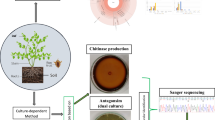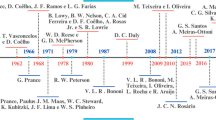Abstract
Eleven lichen species belonging to five families (two fruticose and nine foliose) growing on the bark of Quercus leucotrichophora trees from four forests of Champawat district, Uttarakhand state, northern India were studied for their endolichenic fungal assemblage. We obtained 942 isolates of endolichenic fungi belonging to 33 morphospecies from these lichens. Xylaria spp. dominated the assemblage of 6 of the 11 lichens; it was the most common endolichenic fungus and constituted 31.4% of the total isolates. In co-culture experiments where 33 Xylaria isolates and select endolichenic fungi were cultured together, 39% of the combinations showed mutual stasis, while in 36% of the challenges, Xylaria overgrew the other endolichenic fungus co-cultured with it; Xylaria was inhibited only in 6% of the challenges. Of the 62 isolates tested by bioautogram, 45 and 37 isolates exhibited antialgal and antifungal activity, respectively, while 30 isolates showed both antialgal and antifungal activities. While production of such metabolites by the endolichenic fungi could aid them in overcoming competition within the lichen thallus, it is possible that they also alter the ecological fitness of lichens.

Similar content being viewed by others
References
Arnold AE, Miadlikowska J, Higgins KL, Sarvate SD, Gugger P, Way A, Hofstetter V, Kauff F, Lutzoni F (2009) A phylogenetic estimation of trophic transition networks for ascomycetous fungi: are lichens cradles of symbiotrophic fungal diversification? Syst Biol 58:283–297
Asplund J, Gauslaa Y, Merinero S (2016) The role of fungal parasites in tri-trophic interactions involving lichens and lichen-feeding snails. New Phytol. doi:10.1111/nph.13975
Barnett HL, Hunter BB (1972) Illustrated genera of imperfect fungi, 3 edn. Burgess Publishing Company, Minneapolis
Bills GF, Polishook JD (1992) Recovery of endophytic fungi from Chamaecyparis thyoides. Sydowia 44:1–12
Bills GF, Polishook JD (1994) Abundance and diversity of microfungi in leaf litter of a lowland rain forest in Costa Rica. Mycologia 86:187–198
Chagnon P-L, U’Ren JM, Miadlikowska J, Lutzoni F, Arnold AE (2016) Interaction type influences ecological network structure more than local abiotic conditions: evidence from endophytic and endolichenic fungi at a continental scale. Oecologia 180:181–191
Davis EC, Franklin JB, Shaw AJ, Vilgalys R (2003) Endophytic Xylaria (Xylariaceae) among liverworts and angiosperms: phylogenetics, distribution, and symbiosis. Am J Bot 90:1661–1667
Ellis MB (1971) Dematiaceous hyphomycetes. CMI, Kew
Ellis MB (1976) More dematiaceous hyphomycetes. CMI, Kew
Fisher RA, Corbet AS, Williams CB (1943) The relation between the number of species and the number of individuals in a random sample of an animal population. J Anim Ecol 12:42–58
Govinda Rajulu MB, Thirunavukkarasu N, Babu AG, Aggarwal A, Suryanarayanan TS, Reddy MS (2013) Endophytic Xylariaceae from the forests of Western Ghats, southern India: distribution and biological activities. Mycology 4:29–37
Halama P, Van Haluwin C (2004) Antifungal activity of lichen extracts and lichenic acids. BioControl 49:95–107
Hata K, Futai K (1995) Endophytic fungi associated with healthy pine needles and needles infested by the pine needle gall midge, Thecodiplosis japonensis. Can J Bot 73:384–390
He JW, Chen GD, Gao H, Yang F, Li XX, Peng T, Guo LD, Yao XS (2012) Heptaketides with antiviral activity from three endolichenic fungal strains Nigrospora sp., Alternaria sp. and Phialophora sp. Fitoterapia 83:1087–1091
Kannangara BTSDP, Rajapaksha RSCG, Paranagama PA (2009) Nature and bioactivities of endolichenic fungi in Pseudocyphellaria sp., Parmotrema sp. and Usnea sp. at Hakgala montane forest in Sri Lanka. Lett Appl Microbiol 48:203–209
Lawrey JD, Diederich P (2003) Lichenicolous fungi: interactions, evolution, and biodiversity. Bryologist 106:80–120
Lawrey JD, Torzilli AP, Chandhoke V (1999) Destruction of lichen chemical defenses by a fungal pathogen. Am J Bot 86:184–189
Li WC, Zhou J, Guo SY, Guo LD (2007) Endophytic fungi associated with lichens in Baihua mountain of Beijing, China. Fungal Divers 25:69–80
Li XB, Li L, Zhu RX, Li W, Chang WQ, Zhang LL, Wang XN, Zhao ZT, Lou HX (2015) Tetramic acids and pyridone alkaloids from the endolichenic fungus Tolypocladium cylindrosporum. J Nat Prod 78:2155–2160
Liu X, Dong M, Chen X, Jiang M, Lv X, Zhou J (2008) Antimicrobial activity of an endophytic Xylaria sp. YX-28 and identification of its antimicrobial compound 7-amino-4-methylcoumarin. Appl Microbiol Biotechnol 78:241–247
Miadlikowska J, Arnold A, Lutzoni F (2004) Diversity of cryptic fungi inhabiting healthy lichen thalli in a temperate and tropical forest. Ecol Soc Am Annu Meet 89:349–350
Oliveira CM, Regasini LO, Silva GH, Pfenning LH, Young MCM, Berlinck RGS, Bolzani VS, Araujo AR (2011) Dihydroisocoumarins produced by Xylaria sp. and Penicillium sp., endophytic fungi associated with Piper aduncum and Alibertia macrophylla. Phytochem Lett 4:93–96
Paranagama PA, Wijeratne EMK, Burns AM, Marron MT, Gunatilaka MK, Arnold AE, Gunatilaka AAL (2007) Heptaketides from Corynespora sp. inhabiting the cavern beard lichen, Usnea cavernosa: first report of metabolites of an endolichenic fungus. J Nat Prod 70:700–1705
Schoeman MW, Webber JF, Dickinson DJ (1996) The effect of diffusible metabolites of Trichoderma harzianum on in vitro interactions between basidiomycete isolates at two different temperature regimes. Mycol Res 100:1454–1458
Schueffler A, Anke T (2011) Antimicrobial compounds from tree endophytes. In: Pirttilä AM, Frank AC (eds) Endophytes of forest trees: biology and applications. Springer, New York, pp 265–294
Schulz B, Sucker J, Aust HJ, Krohn K, Ludewig K, Jones PG, Döring D (1995) Biologically active secondary metabolites of endophytic Pezicula species. Mycol Res 99:1007–1015
Schulz B, Guske S, Dammann U, Boyle C (1998) Endophyte–host interactions. II. Defining symbiosis of the endophyte–host interaction. Symbiosis 25:213–227
Schulz B, Boyle C, Draeger S, Römmert A-K, Krohn K (2002) Endophytic fungi: a source of novel biologically active secondary metabolites. Mycol Res 106:996–1004
Schulz B, Haas S, Junker C, Andrée N, Schobert M (2015) Fungal endophytes are involved in multiple balanced antagonisms. Curr Sci 109:39–45
Selbmann L, Grube M, Onofri S, Isola D, Zucconi L (2013) Antarctic epilithic lichens as niches for black meristematic fungi. Biology 2:784–797
Spribille T, Tuovinen V, Resl P, Vanderpool D, Wolinski H, Aime MC, Schneider K, Stabentheiner E, Toome-Heller M, Thor G, Mayrhofer H, Johannesson H, McCutcheon JP (2016) Basidiomycete yeasts in the cortex of ascomycete macrolichens. Science 353:488–492. doi:10.1126/science.aaf8287
Stadler M (2011) Importance of secondary metabolites in the Xylariaceae as parameters for assessment of their taxonomy, phylogeny, and functional biodiversity. Curr Res Environ Appl Mycol 1:75–133
Subramanian CV (1971) Hyphomycetes, an account of Indian species, except Cercosporae. ICAR, New Delhi
Suryanarayanan TS (1992) Light-incubation: a neglected procedure in mycology. Mycologist 6:144
Suryanarayanan TS (2013) Endophyte research: going beyond isolation and metabolite documentation. Fungal Ecol 6:561–568
Suryanarayanan TS, Kumaresan V, Johnson JA (1998) Foliar fungal endophytes from two species of the mangrove Rhizophora. Can J Microbiol 44:1003–1006
Suryanarayanan TS, Thirunavukkarasu N, Hariharan GN, Balaji P (2005) Occurrence of non-obligate microfungi inside lichen thalli. Sydowia 57:120–130
Suryanarayanan TS, Venkatachalam A, Thirunavukkarasu N, Ravishankar JP, Doble M, Geetha V (2010) Internal mycobiota of marine macroalgae from the Tamilnadu coast: distribution, diversity and biotechnological potential. Bot Mar 53:457–468
Tejesvi MV, Tamhankar SA, Kini KR, Rao VS, Prakash HS (2009) Phylogenetic analysis of endophytic Pestalotiopsis species from ethnopharmaceutically important medicinal trees. Fungal Divers 38:167–183
Tripathi M, Joshi Y (2015) Endolichenic fungi in Kumaun Himalaya: a case study. In: Upreti DK, Divakar PK, Shukla V, Bajpai R (eds) Recent advances in lichenology, vol 2. Springer India, New Delhi, pp 111–120
Tripathi M, Gupta RC, Joshi Y (2014a) Physcia dilatata Nyl. (lichenized fungi, Physciaceae); a new host of Bipolaris australiensis (M.B. Ellis) Tsuda & Ueyama from Kumaun Himalaya, India. Natl Acad Sci Lett 37:477–479
Tripathi M, Gupta RC, Joshi Y (2014b) Spegazzinia tessarthra isolated as a true endophyte from lichen Heterodermia flabellata (Fée) D.D. Awasthi. Indian Phytopathol 67:109–110
Tripathi M, Joshi Y, Gupta RC (2014c) Assessment of endolichenic fungal diversity in some forests of Kumaun Himalaya. Curr Sci 107:745–748
U’Ren JM, Lutzoni F, Miadlikowska J, Arnold AE (2010) Community analysis reveals close affinities between endophytic and endolichenic fungi in mosses and lichens. Microb Ecol 60:340–353
U’Ren JM, Lutzoni F, Miadlikowska J, Laetsch AD, Arnold AE (2012) Host and geographic structure of endophytic and endolichenic fungi at a continental scale. Am J Bot 99:898–914
von Arx JA (1974) The genera of fungi sporulating in pure culture, 2nd edn. J. Cramer, Vaduz
Wang QX, Bao L, Yang XL, Guo H, Yang RN, Ren B, Zhang LX, Dai HQ, Guo LD, Liu HW (2012) Polyketides with antimicrobial activity from the solid culture of an endolichenic fungus Ulocladium sp. Fitoterapia 83:209–214
Wang QX, Bao L, Yang XL, Guo H, Ren B, Guo LD, Song FH, Wang WZ, Liu HW, Zhang LX (2013) Tricycloalternarenes F–H: three new mixed terpenoids produced by an endolichenic fungus Ulocladium sp. using OSMAC method. Fitoterapia 85:8–13
Yang F, Chen GD, Gao H, Li XX, Wu Y, Guo LD, Yao XS (2012) Two new naphthalene derivatives from an endolichenic fungal strain Scopulariopsis sp. J Asian Nat Prod Res 14:1059–1063
Yuan C, Wang H-Y, Wu C-S, Jiao Y, Li M, Wang Y-Y, Wang S-Q, Zhao Z-T, Lou H-X (2013) Austdiol, fulvic acid and citromycetin derivatives from an endolichenic fungus, Myxotrichum sp. Phytochem Lett 6:662–666
Yuan C, Guo Y-H, Wang H-Y, Ma X-J, Jiang T, Zhao J-L, Zou Z-M, Ding G (2016) Allelopathic polyketides from an endolichenic fungus Myxotrichum sp. by using OSMAC strategy. Sci Rep 6:19350
Zhang F, Li L, Niu S, Si Y, Guo LD, Jiang X, Che YS (2012) A thiopyranchromenone and other chromone derivatives from an endolichenic fungus, Preussia africana. J Nat Prod 75:230–237
Zhao H, Wang GQ, Tong XP, Chen GD, Huang YF, Cui JY, Kong MZ, Guo LD, Zheng YZ, Yao XS, Gao H (2014) Diphenyl ethers from Aspergillus sp. and their anti-Aβ42 aggregation activities. Fitoterapia 98:77–83
Acknowledgements
TSS thanks PD Dr. Barbara Schulz, Institute of Microbiology, University of Braunschweig, Germany, and Prof. Felix Baerlocher, Mount Allison University, Sackville, Canada, for offering their valuable comments on the draft of the paper.
Author information
Authors and Affiliations
Corresponding author
Ethics declarations
Conflict of interest
The authors declare that there is no conflict of interest.
Additional information
Section Editor: Dominik Begerow
Rights and permissions
About this article
Cite this article
Suryanarayanan, T.S., Govindarajulu, M.B., Rajamani, T. et al. Endolichenic fungi in lichens of Champawat district, Uttarakhand, northern India. Mycol Progress 16, 205–211 (2017). https://doi.org/10.1007/s11557-016-1268-7
Received:
Revised:
Accepted:
Published:
Issue Date:
DOI: https://doi.org/10.1007/s11557-016-1268-7




